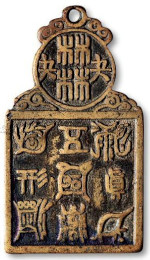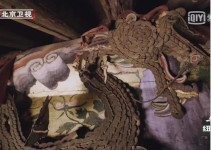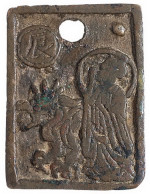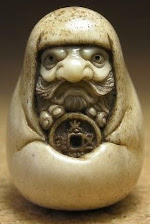Bodhidharma (菩提达摩) was a Buddhist monk who came to China from Central Asia or the Indian subcontinent during the 5th or 6th centuries. Little is known about him but he is regarded as the founder of Chan Buddhism (禅) in China. Chan Buddhism eventually migrated to Japan where it further evolved into what is known [...]
Chinese charms

During the Eastern Jin dynasty (东晋 317-420), map-like charts began to be used as a guide in understanding the ultimate reality, i.e. the “true form” of things according to the Dao (Tao 道), during pilgrimages to China’s Five Great Mountains (五岳). The “true form” is the original, formless, inner shape of the mountain, as part [...]

According to an article in the December 4, 2020 edition of the Science and Technology Daily (科技日报) written by Mr. Zhou Qian (周乾) who is a researcher at the museum, a surprising discovery was made in 2017 during renovation of the Hall of Mental Cultivation (yangxin dian 养心殿) in the Forbidden City (Palace Museum 紫禁城) [...]

One of the most popular ‘good luck’ inscriptions found on old Chinese charms is chang ming fu gui (長命富貴) which is the wish for “long life, riches and honor”. “Chang Ming Fu Gui” pendant (plaque) charm Shown here is a Song dynasty (宋朝 960-1279 AD) pendant (plaque) charm sold in 2009 by Chengxuan Auctions in [...]

When emperors ruled China, the dream of Chinese parents was to have a son successfully pass the imperial examinations and be appointed to an important government position bringing honor and prosperity to the family. The charm displayed below is representative of the Chinese charms expressing such a wish. This bronze charm has finely sculptured characters [...]

This beautifully engraved and gilded shun tian yuan bao (顺天元寶) charm dating from the Tang Dynasty (唐朝) appeared at an auction in China in 2015. Shun tian yuan bao coins were issued during the years 759-761 by Shi Siming (史思明), a rebel leader who seized control of the Tang dynasty capital of Luoyang (洛阳). Luoyang [...]

Lu Dongbin (吕洞宾), a poet and scholar who lived during the Tang dynasty (唐朝 618-907), is one of the rare historical figures who attained the status of an “immortal” in popular culture. He is perhaps the best known of the Chinese “Eight Immortals” (八仙). Over the centuries, Lu Dongbin was posthumously honored with a number [...]

This very attractive hand carved charm from the Qing dynasty (清朝 1644-1912) was sold at a China Guardian auction in Beijing in 2013. The inscription on the obverse side of the charm (shown above) reads lian sheng gui zi (连生贵子) which translates as “May there be the birth of one honorable son after another”. Sons [...]

Wang Bo (王勃) was a Tang dynasty poet and is considered one of the Four Paragons of the Early Tang (初唐四杰). His masterpiece is the Preface to the Prince of Teng’s Pavilion (tengwang ge xu 滕王阁序) which describes the scene at a grand banquet he attended at the Pavilion of Prince Teng. The Pavilion of [...]

This is a rare and exquisitely made charm. However, there is no Chinese inscription and collectors are still uncertain as to its theme. The charm, which first appeared during the Liao (辽朝 907-1125) or Song (宋朝 960-1279) dynasties, is believed to depict huren playing musical instruments, dancing, and doing acrobatics (胡人乐舞杂伎). Hu (胡) means “beard” so [...]

China has historically admired government officials who displayed the highest degree of learning and moral integrity in their work. At the left is a charm which honors such an official. The inscription, written in a particular style of seal script to be discussed later, reads qing bai chuan jia (清白传家) which translates as “pureness handed [...]

On special occasions in ancient times, Chinese mints would cast an unusually large, thick, heavy and well-made coin. The coin was known as a “vault protector” (zhen ku qian 镇库钱). The coin was not for circulation but occupied a special place at the treasury. The treasury had a spirit hall where offerings could be made [...]
